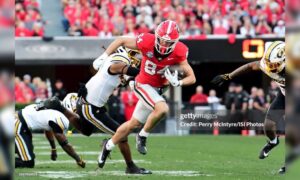By Matthew Marczi
Despite the organization’s strong reputation, the Pittsburgh Steelers have come across their fair share of public relations hiccups through the years thanks to the behavior of their players. They once stood behind a player who shot at a police helicopter. Then, years later, they unceremoniously dumped one player who sucker punched a woman in the face while standing behind another who used an open palm instead of a closed fist.
The perceived hypocrisy between the handling of the latter incidents involving Cedrick Wilson and James Harrison represented a crucial barometer of organization’s principles as the team, and the league as a whole, began to wade into the waters of the 24-hour sports networks and the social media explosion, where everything is public knowledge in an instant.
Ernie Holmes had the fortune of being on a team just coming off its first playoff victory in its then 40-year history in 1973, in a sport not nearly as popular as it is now, in a time when everything wasn’t a headline minutes after it happened.
Chances are high that incidents such as Wilson’s and Harrison’s occurred without being documented for public record then, too. In fact, it is a virtual certainty. But because we now live in an age where every bit of darkness is exposed to the light, some athletes are having a hard time keeping a low profile.
Many athletes today, for example, cannot seem to open their mouths without getting in trouble on social media, such as Twitter. Former Steelers wide receiver Santonio Holmes surely knows all about that. He once told a follower to commit suicide, and later openly acknowledged his use of marijuana, using the phrase “wake n bake”.
Holmes, of course, publicly acknowledged that he was a drug dealer as a teenager. In addition, he was arrested in 2008 for possession of marijuana; the Steelers suspended him for a game following the arrest, and he went on to be named the Most Valuable Player of Super Bowl XLIII for his game-winning catch.
Following the Twitter comment, however, which was prompted by a negative comment left by a follower regarding his alleged involvement in a nightclub incident, the Steelers could only tolerate so much from their top wide receiver. The accumulation of troubles just became too much of a headache, and by the end the team was just happy to be rid of him.
Holmes was arrested twice within a month’s time in 2006. He was arrested for disorderly conduct in May; the charge was dropped after he paid a fine. In June, he was arrested and charged with domestic violence and assault. Although that charge too was dropped after the victim—the mother of his child—supported him and urged the charge be dropped, it never looks good to be arrested for domestic abuse. And that was his background before he was accused of throwing a glass at a woman in a nightclub.
The Steelers became aware that Holmes would be suspended for the first four games of the 2010 season for violating the league’s substance abuse policy after that incident and the Twitter comments surfaced. Enough was enough, and they were all too eager to trade him.
And trade him they did, to the New York Jets, for just a fifth round draft pick (they traded that pick for a later fifth and a sixth. They traded that fifth for cornerback Bryant McFadden, and with the sixth, they drafted Antonio Brown, now the team’s top receiver).
The former first round pick was the team’s top receiver and coming off of a Pro Bowl-caliber season. Holmes’ case is proof positive that production on the field is never enough to make you invulnerable, and netting just a fifth round pick in compensation sent the message that being a Steeler meant more than just playing a game.
2010 was a rough offseason all around for the organization, but the main focus was around one word: Milledgeville. Milledgeville was the location of an incident that likely permanently damaged the organization’s reputation for many observers. Here, in the early hours of March 5th at a local bar, quarterback Ben Roethlisberger was accused of raping a local college student.
It is not my intention, nor my position, to cast judgment on anybody; certainly not the accuser. There are indications that a full investigation of the incident was lacking. Many of the quarterback’s supporters are quick to point out that the underage woman was highly intoxicated and wearing a pin that expressed her willingness to engage in sexual activity.
Neither, of course, is an open invitation for rape. But the details of the case are so murky and unclear even today that the district attorney was unable to charge Roethlisberger with anything, this despite the accuser’s eventual desire to drop her initial complaint, citing a criminal trial as being too invasive of her personal life.
It remains unclear to this day exactly what happened. The DA’s report, however, was lurid enough that it infuriated the Rooney family and the organization as a whole. It did not help that Roethlisberger looked every bit the part of the sleazy degenerate he was accused of being, sporting a greasy, slicked back approximation of a mullet at the time.
As is now well-documented, Roethlisberger would go on to be suspended—first for six games, later dropped to four—and the Steelers would advance to the organization’s eighth Super Bowl in its history, despite coming up short for only the second time.
Make no mistake: despite all of the changes that Roethlisberger has undergone since then, from general maturation to getting married and becoming a father, Milledgeville will always be a part of his legacy, and the organization’s legacy. For many, especially those who have no interest in sports, it will define him.
Many fans of the team even urged the Rooneys to seek a trade for the franchise quarterback. Some, certainly, would still rather see him gone for his perceived wrongdoings. Accompanied with an earlier sexual assault allegation in Lake Tahoe from 2008—which admittedly seems spurious, as the evidence suggests consent—the organization’s decision to ultimately stand by its player will always be perceived as a black mark in its history.
The business reality, however, is that it was the only pragmatic option, no matter how furious Art Rooney II might have been. In the modern era of professional football, the franchise quarterback is equally rare and integral to success. Roethlisberger proved that by taking the team to the Super Bowl that same year. He proved it this past year by evincing the team’s collapse when he was injured.
The Rooneys had their hands tied, and they are just grateful that Roethlisberger finally grew up.
As much as Roethlisberger is synonymous with the Pittsburgh Steelers, however, no player better personified the team than former wide receiver Hines Ward. Beloved by Steelers fans and hated by most others, even he faced a DUI in his last offseason with the organization.
However, there was no public comment on the incident, and no disciplinary action by either the team or the league ever occurred. In fact, Ward ultimately pleaded guilty of a lesser charge of failure to maintain his lane. Of course, his subsequent release in the 2012 offseason had nothing to do with this incident.
Two other players, however, were most certainly released for their actions, as addressed in the first part of this article. Two rookies—nose tackle Alameda Ta’amu and running back Chris Rainey—were released by the team following their discretions, but with very different outcomes.
The circumstances of both players have already been outlined. Ta’amu was suspended by the team for two games after his incident, and subsequently released, then signed to the practice squad. Rainey’s offseason incident was met with a prompt dismissal, and he remains a free agent.
The discrepancy in response lies, I think, in the organization’s belief that Ta’amu’s problem stemmed from a deeper personal issue, and that his behavior was unintentional. Rainey, on the other hand, already had a history of potential violence. He was an ultimately insignificant, expendable player who made the organization look bad despite the fact that he was given a chance to prove himself. It was an easy decision.
As for Ta’amu, he is by all accounts a laid back, family-oriented person, well-liked by everybody in the organization. He never made any excuses for his behavior, although others have; he has done all the right things since the incident. He accepted responsibility for his actions and claims to have stopped drinking. He also sounds far more mature than he did a year ago. He sounds like the person the Steelers believed him to be when they gave him a second chance, giving him the opportunity to get his life back together.
That is, of course, just an opportunity. Ta’amu, already on a short leash thanks to his indiscretions, is guaranteed nothing. In OTAs, defensive end Al Woods even played reserve nose tackle ahead of him, and he is in a stiff competition with fellow second-year player Hebron Fangupo.
For the Steelers, more so than in most organizations, character counts, and that comes down from the Rooney family. No matter how much he excelled on the field, Santonio Holmes had to go. He did not fit the character description. Likewise, despite his incident, the Steelers still believe that Ta’amu is a better person than the intoxicated and bewildered young man adapting to a new lifestyle that made a stupid decision this past October.
Much unlike last year, there do not appear to be any red flags from the team’s most recent draft class. From Jarvis Jones and Le’Veon Bell to Shamarko Thomas and Vince Williams, high character seems to have been equally as important as high talent. I suspect that this is not a coincidence. And after the last few offseasons, that is probably a good thing.







